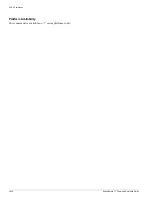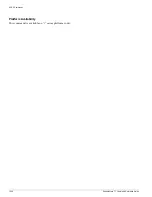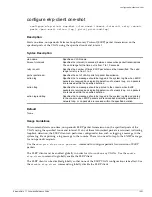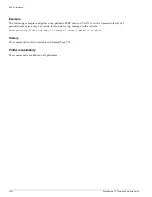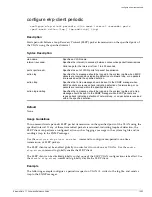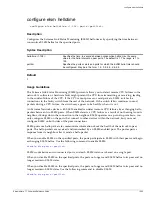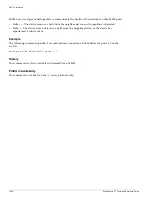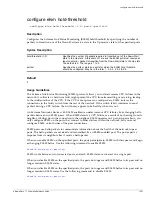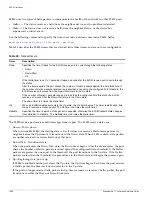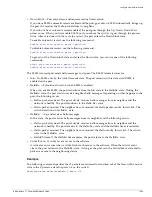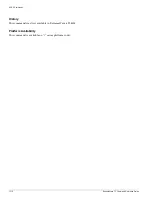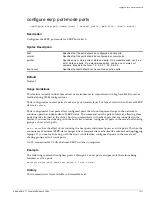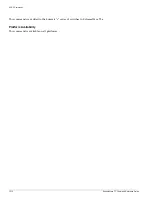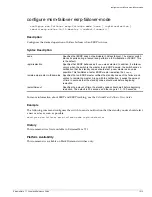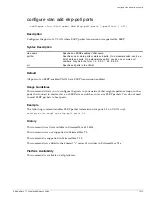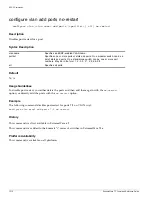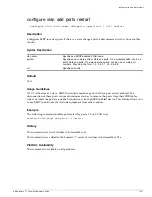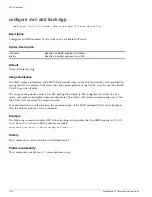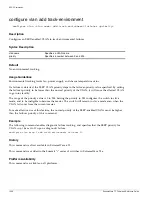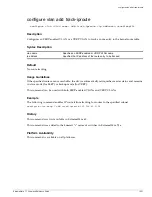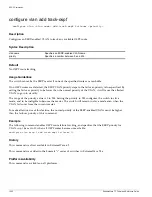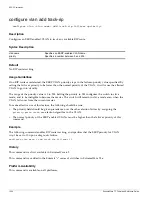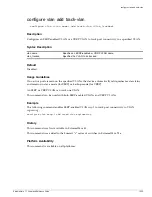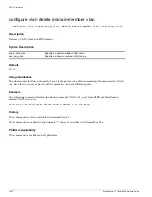
configure esrp port-mode ports
ExtremeWare 7.7 Command Reference Guide
1511
configure esrp port-mode ports
configure esrp port-mode [host | normal] ports <portlist> {don’t-count}
Description
Configures the ESRP port mode for ESRP host attach.
Syntax Description
Default
Normal.
Usage Guidelines
This feature is useful in dual-homed server environments in conjunction with high availability server
load-balancing (SLB) configurations.
Ports configured as normal ports do not accept or transmit layer 2 or layer 3 traffic when the local ESRP
device is a slave.
Ports configured as host ports allow configured ports that do not represent loops to the network to
continue operation independent of ESRP status. The command sets the port to forward, allowing those
ports directly attached to the slave’s hosts to communicate with other hosts that are connected to the
master. If you use load sharing with the host attach feature, configure all ports in the same load sharing
groups as host attach ports.
don’t-count
has the effect of not counting the host ports and normal ports as active ports. This has the
convenience of minimal ESRP state changes due to frequent client activities like reboots and unplugging
laptops. If you use load sharing with the don’t count feature, configure all ports in the same load
sharing group as don’t count ports.
An L2 connection for VLANs between ESRP switches is required.
Example
The following command configures ports 1 through 5 as host ports, and prevents them from being
counted as active ports:
configure esrp port-mode host ports 1-5 don’t-count
History
This command was first available in ExtremeWare 6.1.
host
Specifies that the ports should be configured as host ports.
normal
Specifies that the ports should be configured as normal ports.
portlist
Specifies one or more ports or slots and ports. On a modular switch, can be a
list of slots and ports. On a stand-alone switch, can be one or more port
numbers. May be in the form 1, 2, 3-5, 2:*, 2:5, 2:6-2:8.
don’t-count
Specifies that ports should not be counted as active ports.
Summary of Contents for ExtremeWare 7.7
Page 60: ...60 ExtremeWare 7 7 Command Reference Guide Contents ...
Page 72: ...72 ExtremeWare 7 7 Command Reference Guide Command Reference Overview ...
Page 404: ...404 ExtremeWare 7 7 Command Reference Guide VLAN Commands ...
Page 472: ...472 ExtremeWare 7 7 Command Reference Guide QoS Commands ...
Page 492: ...492 ExtremeWare 7 7 Command Reference Guide NAT Commands ...
Page 890: ...890 ExtremeWare 7 7 Command Reference Guide Security Commands ...
Page 1130: ...1130 ExtremeWare 7 7 Command Reference Guide Security Commands ...
Page 1164: ...1164 ExtremeWare 7 7 Command Reference Guide Configuration and Image Commands ...
Page 1436: ...1436 ExtremeWare 7 7 Command Reference Guide Wireless Commands ...
Page 1490: ...1490 ExtremeWare 7 7 Command Reference Guide EAPS Commands ...
Page 1576: ...1576 ExtremeWare 7 7 Command Reference Guide ESRP Commands ...
Page 1774: ...1774 ExtremeWare 7 7 Command Reference Guide IP Unicast Commands ...
Page 1914: ...1914 ExtremeWare 7 7 Command Reference Guide IGP Commands ...
Page 2000: ...2000 ExtremeWare 7 7 Command Reference Guide BGP Commands i Series Switches Only ...
Page 2140: ...2140 ExtremeWare 7 7 Command Reference Guide IPX Commands i Series Platforms Only ...
Page 2156: ...2156 ExtremeWare 7 7 Command Reference Guide ARM Commands BlackDiamond Switch Only ...
Page 2168: ...2168 ExtremeWare 7 7 Command Reference Guide Remote Connect Commands ...
Page 2346: ...2346 ExtremeWare 7 7 Command Reference Guide PoS Commands BlackDiamond Switch Only ...
Page 2446: ...2446 ExtremeWare 7 7 Command Reference Guide LLDP Commands ...
Page 2496: ...2496 ExtremeWare 7 7 Command Reference Guide H VPLS Commands BlackDiamond Switch Only ...
Page 2620: ...2620 ExtremeWare 7 7 Command Reference Guide Index of Commands ...


